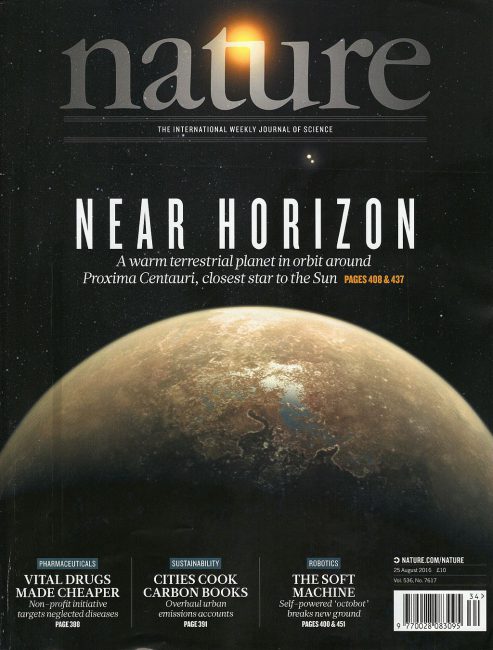
Nature volume 536 number 7617 cover displaying an artist’s impression of Proxima Centauri, Photo: ESO/M. Kornmesser (photo displayed on the magazine cover), [CC-BY 4.0]
On 4 November 1869, the very first issue of the prominent interdisciplinary scientific journal ‘Nature‘ was published. It is widely regarded as one of the few remaining academic journals that publish original research across a wide range of scientific fields and was ranked the world‘s most cited journal.
Scientific Journals
The history of scientific journals dates from 1665, when the French Journal des sçavans and the English Philosophical Transactions of the Royal Society first began systematically publishing research results.[7] Over a thousand, mostly ephemeral, were founded in the 18th century, and the number has increased rapidly after that. Scientific journals played an important role with the enormous technological, scientific, and industrial improvements that evolved during the 19th century. Other journals were primarily written in German or French. The goal was to bring the scientific world closer to the masses and make it understandable for everyone. ‘Recreative Science: A Record and Remembrancer of Intellectual Observation‘ presumably belongs to Nature’s closest predecessors. It was created in 1859 and also the ‘Popular Science Review‘ starting in 1862 covered various fields of science. Popular Science Review survived the longest with 20 years of publishing, the others basically failed at some point earlier.
Nature
The English scientist and astronomer, Norman Lockyer,[8] who is credited with discovering the gas helium (along with Pierre Janssen)[10] got the idea of creating another scientific journal he named ‘Nature‘. Lockyer was also the editor-in-chief of the journal until 1919. First of all, the journal was very similar to its predecessors with the goal to “provide cultivated readers with an accessible forum for reading about advances in scientific knowledge“. Famous authors of the journal’s early days were members of the so called ‘X-club’. Its initiator was Tomas Henry Huxley and the club in general supported back then controversial theories like natural selection. The club claimed to be united by “devotion to science, pure and free, untrammelled by religious dogmas“. One of the editors, John Maddox later stated that these and other articles found in the journal meant real journalism and were the reason that ‘Nature‘ became a lasting success. The first article published an English translation of the essay Die Natur by Johann Wolfgang von Goethe.[9]
During the years, the journal expanded and got more and more international. Sir Richard Gregory, who succeeded Lockyer as editor-in-chief in 1919, was responsible to do so. His obituary by the Royal Society stated: “Gregory was always very interested in the international contacts of science, and in the columns of Nature he always gave generous space to accounts of the activities of the International Scientific Unions.” The first branches outside the U.S. opened in Munich and Tokyo in 1987 followed by Paris and Hong Kong. The Nature Website was established in 1997, publishing several articles for free. Two years later, the journal also began publishing science fiction stories that now appear weekly.
The impact of Nature is immense
Being published in Nature is very prestigious. In particular, empirical papers are often highly cited, which can lead to promotions, grant funding, and attention from the mainstream media. Because of these positive feedback effects, competition among scientists to publish in high-level journals like Nature and its closest competitor, Science, can be very fierce. Nature’s impact factor, a measure of how many citations a journal generates in other works, in 2016 was 40.137 and the five-year impact factor 43.769 (as measured by Thomson ISI), among the highest of any science journal.
Peer Review
As with most other professional scientific journals, papers undergo an initial screening by the editor, followed by peer review (in which other scientists, chosen by the editor for expertise with the subject matter but who have no connection to the research under review, will read and critique articles), before publication. In the case of Nature, they are only sent for review if it is decided that they deal with a topical subject and are sufficiently ground-breaking in that particular field. As a consequence, the majority of submitted papers are rejected without review.
‘
A network of science: 150 years of Nature papers, [11]
References and Further Reading:
- [1] An electronic version of the first issue from 1869
- [2] Nature’s Official website
- [3] Nature archive, 1869–present
- [4] History of the journal Nature
- [5] Nature’s YouTube Channel
- [6] Nature at Wikidata
- [7] The Philosophical Transactions of the Royal Society, SciHi Blog
- [8] Joseph Norman Lockyer – a Pioneer of Modern Astrophysics and Founder of Archaeoastronomy, SciHi Blog
- [9] Johann Wolfgang von Goethe and his Theory of Colours, SciHi Blog
- [10] Pierre Janssen and the Discovery of Helium, SciHi Blog
- [11] A network of science: 150 years of Nature papers, Nature Video @ youtube
- [12] Timeline of academic journals of nature research, via DBpedia and Wikidata






Pingback: Whewell’s Gazette: Year 3, Vol. #12 | Whewell's Ghost